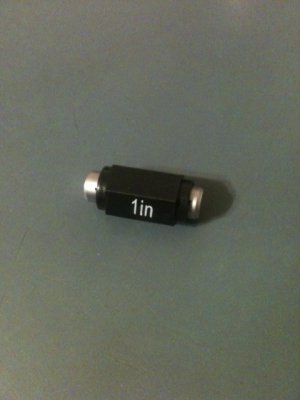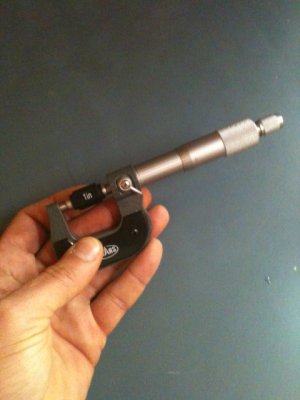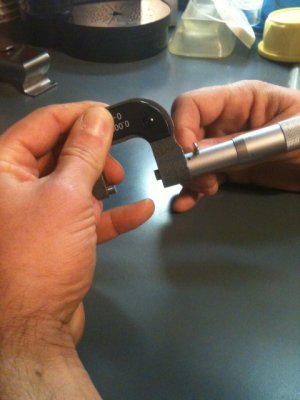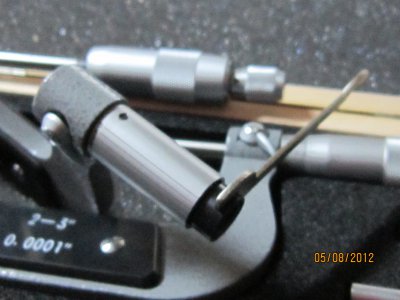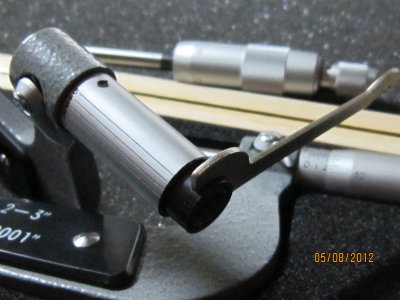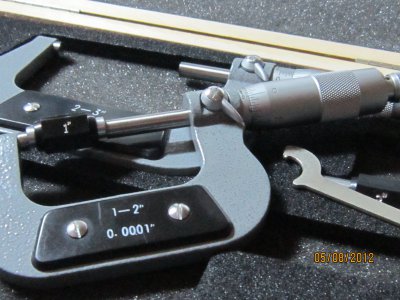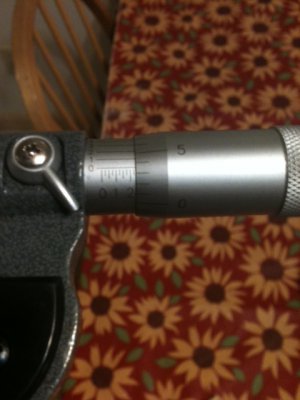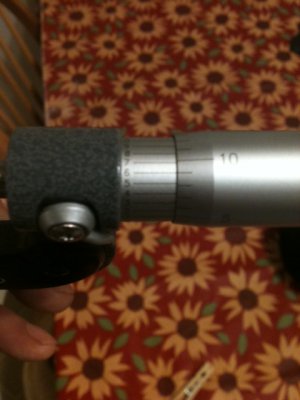Ok, so what Billy G is pointing out is that if a mic zeros when closed then, when a known proof bar (or ball) of 1 inch is measured, it better read as 1 inch -and if it doesn't the mic is probably toast (maybe). There are other factors to consider. If the mic has been in the cold garage and the test bar has been in your pocket, nice and toasty, it has probably expanded a bit. Let them sit together long enough to be the same temperature and believe it or not, a specific temperature is ideal. I believe 68 degrees F. is the correct temperature -but I might be wrong on that. We'll need to find out and chime-in if you know the answer.
Here's some steps and a few pics to show the points.
1) Clean the contact surfaces, visually check for swarf etc and close the mic with enough finger pressure to make contact without too much force. This just takes practice -and some folks use the ratchet feature at the end of the spindle. Being consistent is the key.
2) Read the mic. It should read zero and we'll assume for now that it does. If it doesn't it needs calibration and we'll get to that.
3) Open the mic all the way, insert the 1" test bar, close down with the same technique as before and read the mic. It should read 1 inch. If it does, you're set to go unless of course, you check with a 1/2" standard bar and it doesn't read 1/2" when it's supposed to. Again, we'll get to that later.
If the mic zeroed when closed as in steps 1 & 2 then doesn't read 1" as in step 3, there's probably a problem if both were at the same, correct temperature. There's always a possibility the 1" test bar is inaccurate -so you need to use a good, known standard.
Now what if your mic didn't zero as in steps 1 & 2? ...The sleeve on a mic is adjustable with a small spanner wrench The spanner hole (or holes) are on the backside of the sleeve. See the picture. It doesn't take much of a turn but, twist the sleeve with the wrench until the mic reads zero when closed (as in steps 1 & 2). It usually takes a few shots at adjusting the sleeve to get it dead on. Now repeat the 3 steps above. If it still doesn't read properly at both ends of the calibration process, it likely means the frame is bent. -Probably time to retire that mic.
... And what happens when you have a mic that reads zero and 1" when it's supposed to but, doesn't read properly at intermediate sizes? Again, if the temperatures are correct and normalized and you're using a true test standard, it means the mic is shot and most likely the threads in the spindle are worn unevenly or were never right in the first place.
Ok, there's a shot at this process. Please comment, check the spelling and punctuation errors and we'll add, delete or make corrections as necessary. Also, we should hit on a review of reading a mic and also how to read ten-thousandths if the mic support it. And finally, we can talk about what that sleeve with the spanner hole is for if you unscrew the thimble out of the sleeve...
Thanks for hanging in there with this and we'll hit more topics soon. And in the mean time, don't wait for me to start-up new conversations.
Ray
